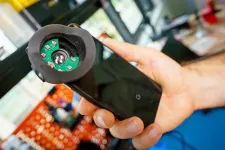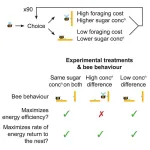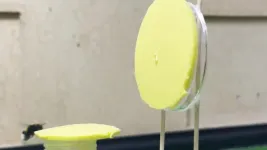(Press-News.org) In a new case report, researchers at UCLA Health describe promising results using repetitive transcranial magnetic stimulation (rTMS) in the management of post-stroke cerebellar ataxia, a debilitating condition marked by impaired coordination and balance.
Cerebellar ataxia describes a group of neurological disorders that affect coordination, balance, and control of muscle movements. It results from damage or dysfunction of the cerebellum, a part of the brain responsible for coordinating voluntary movements. Ataxia can manifest as unsteady walking, difficulties with fine motor skills, and problems with speech, among other symptoms. The severity of ataxia can vary from mild to severe, and treatments often aim to manage symptoms and improve a person's quality of life as treatment options are limited.
Writing in The Cerebellum, researchers led by Evan Hy Einstein, Department of Psychiatry & Biobehavioral Sciences at the UCLA David Geffen School of Medicine, report on the case of a 58-year-old male who had experienced a cerebellar hemorrhage approximately 12 years previously. Despite intensive rehabilitation, symptoms such as slow and unsteady gait, balance issues, and urinary incontinence persisted over the years. The patient sought consultation for potential rTMS treatment. His primary complaints focused on his slow and unsteady gait, along with challenges related to balance and stability. The decision was made to employ bilateral cerebellar rTMS, representing an innovative approach to address the condition.
Over five daily sessions, the patient underwent rTMS targeting both the right and left cerebellar hemispheres. The patient reported subjective improvement after just two days of stimulation. By the fifth day, there were noticeable improvements. The patient's walking speed increased from 0.57 m/s to 0.60 m/s, and his balance improved, as measured by the Berg Balance Scale, which rose from 27 to 38. More significantly, the patient was able to rise from sitting unaided and was able to bend to pick up a pencil from the floor easily. He reported improved balance and stability in that he could stand unaided and without using hand supports while performing activities of daily living in the bathroom (e.g., showering and shaving), which he was unable to do prior to treatment.
“This case represents the first instance of bilateral cerebellar rTMS used to treat post-stroke cerebellar ataxia,” said Dr. Einstein. “Further research is warranted to ascertain long-term clinical benefits and explore the underlying neural mechanisms of this innovative treatment, but It underscores the potential of tailored treatment protocols that consider the specific etiology of ataxia.”
Article: Einstein, E.H., Corlier, J., Matthews, C. et al. Bilateral Cerebellar Repetitive Transcranial Magnetic Stimulation for Chronic Ataxia After Hemorrhagic Stroke: a Case Report. Cerebellum (2023). https://doi.org/10.1007/s12311-023-01618-1
END
Case report shows promising results using transcranial magnetic stimulation for post-stroke ataxia
Case represents first use of TMS to treat post-stroke cerebellar ataxia
2023-10-24
ELSE PRESS RELEASES FROM THIS DATE:
$9 million award from the Department of Defense will fund groundbreaking FutureG research
2023-10-24
Lingjia Liu, professor of electrical and computer engineering who is also an inaugural faculty member at the Virginia Tech Innovation Campus, has been awarded the Mobile Distributed Multiple-Input, Multiple-Output (Mobile dMIMO) project by the U.S. Department of Defense’s (DoD’s) Office of the Under Secretary of Defense for Research and Engineering (OUSD(R&E)) as part of its flagship FutureG program. The Mobile dMIMO project consists of three phases, with $9 million total planned funding — $1.5 million is for Phase 1 of the project. The Mobile dMIMO project represents one ...
Smartphone attachment could increase racial fairness in neurological screening
2023-10-24
Engineers at the University of California San Diego have developed a smartphone attachment that could enable people to screen for a variety of neurological conditions, such as Alzheimer’s disease and traumatic brain injury, at low cost—and do so accurately regardless of their skin tone.
The technology, published in Scientific Reports, has the potential to improve the equity and accessibility of neurological screening procedures while making them widely available on all smartphone models.
The attachment fits over a smartphone’s camera and improves its ...
New methods for effective transport of large genes in gene therapy
2023-10-24
Gene therapy currently represents the most promising approach for the treatment of hereditary diseases. Yet despite significant breakthroughs in recent years, there are still a number of hurdles that hinder the wider application of gene therapies. These include the efficient delivery of genetic material into target cells with minimal side effects using adeno-associated viral vectors (AAVs). The AAV carrier substances have an advantageous safety profile and high gene transfer efficiency, meaning they are often used in gene therapies and in gene editing with CRISPR/Cas. But, AAVs have limited DNA uptake capacity ...
New tool may flag signs of pandemic-related anxiety and depression in healthcare workers
2023-10-24
An artificial intelligence tool effectively detected distress in hospital workers’ conversations with their therapists early in the pandemic, a new study shows, suggesting a potential new technology that screens for depression and anxiety.
As the coronavirus pandemic forced many hospitals to operate beyond capacity, medical workers faced overwhelming numbers of work shifts, limited rest, and increased risk of COVID-19 infection. At the same time, quarantine policies and fear of infecting family reduced their ...
Bumblebees visit flowers with more difficult-to-access nectar for immediate benefit to the colony
2023-10-24
If you’ve ever watched a bumblebee move from flower to flower, you might wonder how they decide which flower to choose and how long to stay. Now, researchers reporting in the journal iScience on October 24 have new insight based on their observations of bumblebees’ interactions with slippery artificial flowers. They found that the bumblebees make choices to maximize the rate of energy return, or the amount of sugar collected each minute.
“Bumblebees can make decisions ‘on the fly’ about which nectar sources are the most energetically economical,” said Jonathan ...
Making chemistry more accessible at the University of Oxford by providing period products
2023-10-24
When it comes to the question of who gets to be a scientist, gender disparities are well-documented in many fields. Patching the infamous “leaky pipeline” can be a thorny problem, but during the 2022–2023 school year, the Department of Chemistry at the University of Oxford took a simple and practical step forward: they began offering period products in the department’s bathrooms. In an article publishing October 25 in the journal Trends in Chemistry, three students involved in the Oxford Period Project and their supervising ...
Traditional chinese medicine compound (tongxinluo) and clinical outcomes of patients with acute myocardial infarction
2023-10-24
About The Study: In this randomized clinical trial of 3,777 patients with ST-segment elevation myocardial infarction (STEMI; a type of heart attack), the Chinese patent medicine Tongxinluo, as an adjunctive therapy in addition to STEMI guideline-directed treatments, significantly improved both 30-day and 1-year clinical outcomes. Further research is needed to determine the mechanism of action of Tongxinluo in STEMI.
Authors: Yuejin Yang, M.D., Ph.D., and Runlin Gao, M.D., of the Chinese Academy of Medical ...
Getting maximum calories in shortest time is the priority for bumblebees
2023-10-24
Research has found that bumblebees make foraging choices to collect the most sugar from flowers in the shortest time – even if that means using more energy in the process – to provide an immediate energy boost for the colony.
A new study investigating nectar drinking in one of the most common bumblebees in the UK, Bombus terrestris, has found that when foraging they maximise the amount of nectar sugar they take back to the colony each minute.
To make their choices, the bumblebees trade off the time they spend collecting nectar with the energy content of that nectar. This means ...
Incidence and transmission of SARS-CoV-2 in child care centers after COVID-19 vaccines
2023-10-24
About The Study: In this examination of SARS-CoV-2 incidence and transmission in child care centers (CCCs) and students’ households, transmission within CCCs and from children infected at CCCs into households was low in this study that included 83 children in 11 CCCs. These findings suggest that current testing and exclusion recommendations for SARS-CoV-2 in CCCs should be aligned with those for other respiratory viruses with similar morbidity and greater transmission to households.
Authors: Timothy R. Shope, ...
Neurodevelopmental outcomes among offspring exposed to corticosteroid and B2-adrenergic agonists in utero
2023-10-24
About The Study: The results of this study of 91,460 mother-offspring pairs found no association between in utero corticosteroid and β2-adrenergic agonist exposure and offspring neurodevelopmental outcomes, regardless of the timing of exposure. Despite the limitations and low power of the study, the findings suggest that corticosteroids and β2-adrenergic agonists are safe for pregnant individuals with asthma and the neurodevelopment of their offspring.
Authors: Abir Nagata, Ph.D., of Osaka University in Osaka, Japan, and Toshio Masumoto, Ph.D., of Tottori University ...
LAST 30 PRESS RELEASES:
Humans rank between meerkats and beavers in monogamy ‘league table’
US fossil reveals early mass-burial event and ancient microbial attack
Sedative choice could improve outcomes for breathing tube patients
New superconducting thin film for quantum computer chips
Simulations reveal protein "dynamin" constricts cell membranes by loosening its grip
Nearly 1 in 5 UK emergency department patients cared for in corridors/waiting rooms
Heavy energy drink intake may pose serious stroke risk, doctors warn
Violence against women and children among top health threats: New global study reveals disease burden far larger than previously estimated
Predicting who is at risk of developing type 1 diabetes, as new drugs now available
New gene-mapping method unlocks hidden drivers of cancer
Ocean current and seabed shape influence warm water circulation under ice shelves
Call to increase funding for ‘invisible’ Deaf victim-survivors of domestic abuse
University of Maryland School of Medicine names distinguished scientist and academic leader Gerald M. Wilson, PhD, as Chair of the Department of Biochemistry and Molecular Biology
Receptors in mammary glands make livestock and humans inviting hosts for avian flu
Icy hot plasmas
Treating adults with autism: Maryland Clinical Center offers national blueprint for care after pediatric transition
University of Phoenix College of Doctoral Studies releases white paper on reclaiming control to build workforce resilience
NCCN Summit seeks to improve care for veterans and first responders with cancer from line-of-duty exposure
ERC Consolidator Grant for soft robotics researcher
Dual-action arts and wellbeing program transforms dementia care
The global plastic waste trade contributes to coastal litter in importing countries, study shows
UT Dallas partners with Tech Mahindra on AI innovation
Blinking less could signal the brain is working harder to listen, Concordia study shows
Male bonobos track females’ reproductive cycle to maximize mating success
New report outlines science priorities for human Mars exploration
Want to curb cannabis-related crashes? Don’t forget older adults, study finds
Expectant management vs medication for patent ductus arteriosus in preterm infants
Pew funds 7 new biomedical research collaborations
The ERC selects 349 mid-career researchers for €728 million in Consolidator Grants
ERC Consolidator Grant awarded to CISPA researcher Rayna Dimitrova
[Press-News.org] Case report shows promising results using transcranial magnetic stimulation for post-stroke ataxiaCase represents first use of TMS to treat post-stroke cerebellar ataxia




